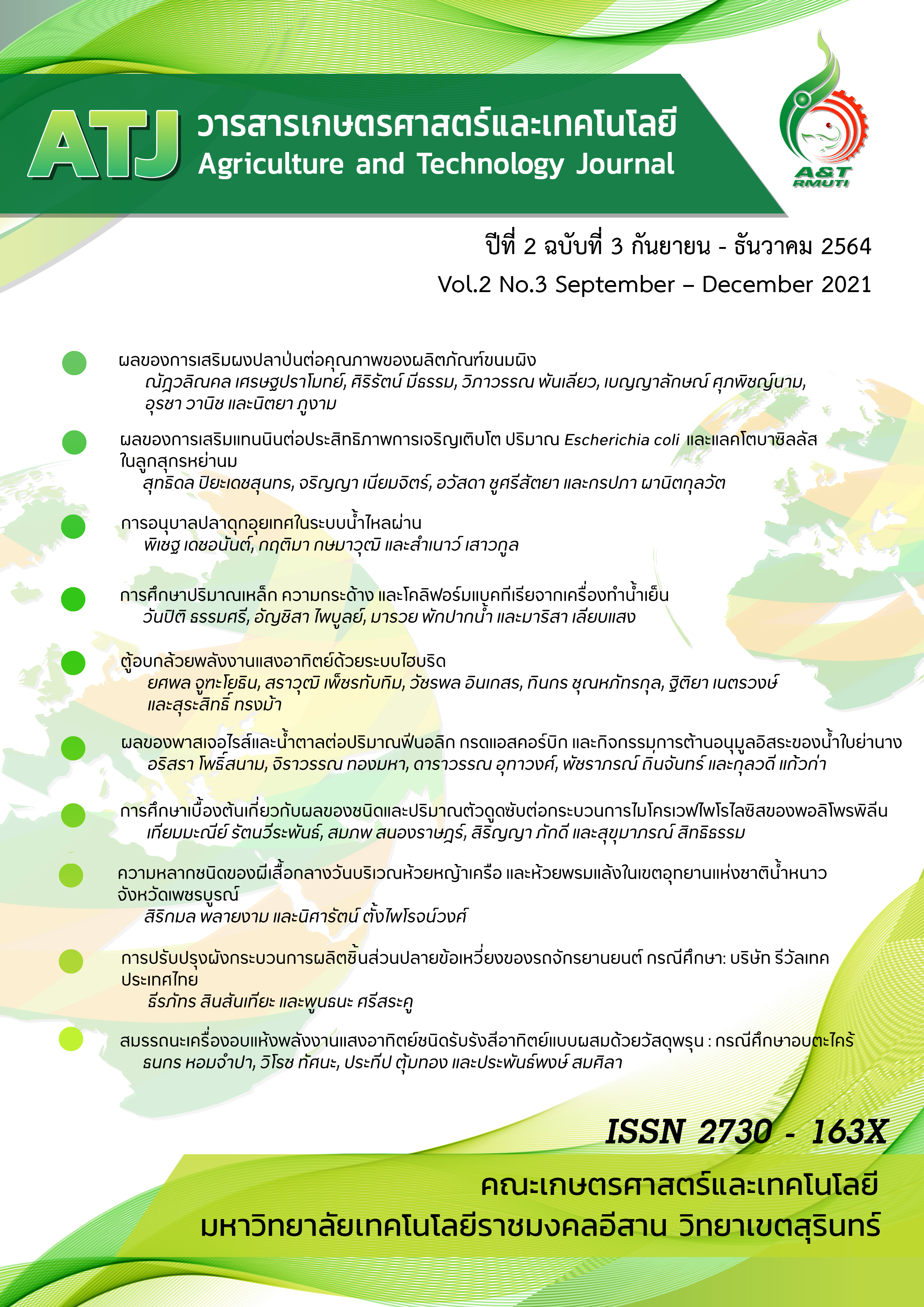ผลของการเสริมแทนนินต่อประสิทธิภาพการเจริญเติบโต ปริมาณ Escherichia coli และแลคโตบาซิลลัสในลูกสุกรหย่านม
คำสำคัญ:
แทนนิน, เชื้อ อี. โคไล, แลคโตบาซิลลัส, ลูกสุกรหย่านมบทคัดย่อ
แทนนิน (Tannin) คือ สารประกอบโพลิฟีนอลตามธรรมชาติ สามารถลดการย่อยได้ของโปรตีนในอาหารและมีคุณสมบัติต้านเชื้อแบคทีเรีย การทดลองนี้มีวัตถุประสงค์เพื่อศึกษาการเสริมแทนนินต่อปริมาณ E. coli และแลคโตบาซิลลัสของลูกสุกรหย่านม วางแผนการทดลองแบบสุ่มสมบูรณ์ (Completely Randomized Design; CRD) โดยใช้ลูกสุกรหย่านม (ดูร็อค × แลนด์เรซ × ลาร์จไวท์) จำนวน 12 ตัว น้ำหนักเฉลี่ย 8.11±0.56 กิโลกรัม แบ่งกลุ่มการทดลองเป็น 3 กลุ่ม กลุ่มละ 4 ซ้ำ ๆ ละ 1 ตัว ได้แก่ T1) กลุ่มควบคุม (Placebo; distilled water) T2) แทนนิน 1% และ T3) กลุ่มควบคุมผลบวก (ยาปฏิชีวนะ Enrofloxacin; 1–3 วัน) ใช้ระยะเวลาการทดลอง 7 วัน จากผลการทดสอบในห้องปฏิบัติการ (in vitro) พบว่าแทนนินที่ระดับ 1% สามารถยับยั้ง E. coli (108 CFU/ml) ได้ระดับวงใสขนาด7.00±0.00 มิลลิเมตร การเสริมแทนนินในปริมาณ 1% อย่างต่อเนื่องในกลุ่ม T2 ทำให้ปริมาณ E. coliลดลงจาก 1.12±0.69 MPN/ml เป็น 0.62±0.52 MPN/ml ผลต่ออัตราการเจริญเติบโตเฉลี่ยต่อวันสูงสุดที่ระดับ 457.25±0.04 กรัม (p>0.05) และส่งผลต่อระดับปริมาณความเข้มข้นของแลคโตบาซิลลัสคงที่ (4.03±1.70-4.96±1.85 log CFU/ml) สรุปได้ว่าการเสริมแทนนินในการเลี้ยงลูกสุกรหย่านมไม่ส่งผลต่อประสิทธิภาพการเจริญเติบโตและปริมาณ E. coli แต่มีแนวโน้มที่ดีกว่ากลุ่มทดลองอื่นในลูกสุกรหย่านมและทำให้ระดับปริมาณความเข้มข้นของแลคโตบาซิลลัสในลูกสุกรหย่านมมีความคงที่ซึ่งส่งผลดีต่อลูกสุกร
References
Antje R., Gesine S., Saskia R., Jessica M., Jurgen W., Manfred K. and Heike K. (2017). Effects of intramuscularly administered Enrofloxacin on the susceptibility of commensal intestinal Escherichia coli in pigs (Susscrofa domestica). BMC Veterinary Research. 10: 118-126.
Brus M., Dolinsek J., Cencic A. and Skorjanc D. (2013). Effect of chestnut (Castanea sativa Mill) wood tannins and organic acids on growth performance and faecal microbiota of pigs from 23 to 127 days of age. Agricultural Science. 19(4): 841-847.
Caprarulo V., Giromini C. and Rossi L. (2021). Review: Chestnut and quebracho tannins in pig nutrition: the effects on performance and intestinal health. Animal. 15(1): 100064.
Dowarah R., Verma A.K. and Agarwal N. (2017). The use of Lactobacillus as an alternative of antibiotic growth promoters in pigs: A review. Animal Nutrition. 3(1): 1–6.
Faccin J.E.G., Laskoski F., Cemin H.S., Mellagi A.P.G., Bernardi M.L., Ulguim R.R., Bortolozzo F.P. and Tokach M.D. (2020). Evaluating the impact of weaning weight and growth rate during the first week post weaning on overall nursery performance. Journal of Swine Health and Production. 28(2): 70–78.
Foditsch C., Pereira R.V.V., Siler J.D., Altier C. and Warnick L.D. (2019). Effects of treatment with enrofloxacin or tulathromycin on fecal microbiota composition and genetic function of dairy calves. Plos One 14(12): e0219635.
Giacomo B. and Pinna C. (2010). The utilization of prebiotics and symbiotics in pig. Italian Journal of Animal Science. 13: 169–178.
Girard M. and Bee G. (2020). Invited review: Tannins as a potential alternative to antibiotics to prevent coliform diarrhea in weaned pigs. Animal. 14(1): 95–107.
Hudzicki J. (2009). Kirby-Bauer disk diffusion susceptibility test protocol. Journal of American Society for Microbiology. 1-23.
Marion G., Sophie T., Nicolas P., Dou H., Catherine O. and Giuseppe B. (2018). Hydrolysable chestnut tannins for reduction of postweaning diarrhea: efficacy on an experimental ETEC F4 Model. Plos One. 13(5): 1–15.
McDevitt S. (2009). Methyl Red ang Voges-Proskauer test protocols. Journal of American Society for Microbiology. 1-9.
Min B.R., Pinchak W.E., Merkel R., Walker S., Tomita G. and Anderson R.C. (2008). Comparative antimicrobial activity of tannin extracts from perennial plants on mastitis pathogens. Scientific Research and Essays. 3(2): 066–073.
Mohamed R., Fairbrother J.M., Beaudry F. and Letellier A. (2017). Postweaning diarrhea in pig: risk factors and non-Colistin-based control strategies. Acta Veterinaria Strategies. 59(31): 1-19.
Myers D.N., Stoeckel D.M., Bushon R.N., Francy D.S. and Brady A.M.G. (2007). Fecal indicator bacteria: U.S. geological survey techniques of water-resources investigations, book 9, chap. A7, section 7.1 (version 2.0)
Smith A.C. and Hussey M.A. (2005). Gram stain protocols. American Society for Microbiology, 1(September 2005), 14.
Sudthidol P., Pairat S., Udom C. and Bopit P. (2018). Effect of Lactobacillus probiotics supplementation on intestinal bacteria and growth performance in weaned pigs. Veterinary Integrative Sciences. 16(3): 211–221.
Yu J., Song Y., Yu B., He J., Zheng P., Mao X., Huang Z., Luo Y., Luo J., Yan H., Wang Q., Wang H. and Chen D. (2020). Tannic acid prevents post-weaning diarrhea by improving intestinal barrier integrity and function in weaned piglets. Journal of Animal Science Biotechnology. 87: 1-11.
Downloads
เผยแพร่แล้ว
Versions
- 16-02-2024 (3)
- 31-12-2021 (2)
- 30-12-2021 (1)
How to Cite
ฉบับ
บท
License
Copyright (c) 2021 วารสารเกษตรศาสตร์และเทคโนโลยี

This work is licensed under a Creative Commons Attribution-NonCommercial-NoDerivatives 4.0 International License.
เนื้อหาและข้อมูลในบทความที่ลงตีพิมพ์ในวารสารทดสอบระบบ ThaiJo2 ถือเป็นข้อคิดเห็นและความรับผิดชอบของผู้เขียนบทความโดยตรงซึ่งกองบรรณาธิการวารสาร ไม่จำเป็นต้องเห็นด้วย หรือร่วมรับผิดชอบใดๆ
บทความ ข้อมูล เนื่อหา รูปภาพ ฯลฯ ที่ได้รับการดีพิมพ์ในวารสารทดสอบระบบ ThaiJo2 ถือเป็นลิขสิทธิ์ของวารสารทดสอบระบบ ThaiJo2 หากบุคคลหรือหน่วยงานใดต้องการนำทั้งหมดหรือส่วนหนึ่งส่วนใดไปเผยแพร่หรือเพื่อกระทำการใดๆ จะต้องได้รับอนุญาตเป็นลายลักอักษรณ์จากวารสารทดสอบระบบ ThaiJo2 ก่อนเท่านั้น






